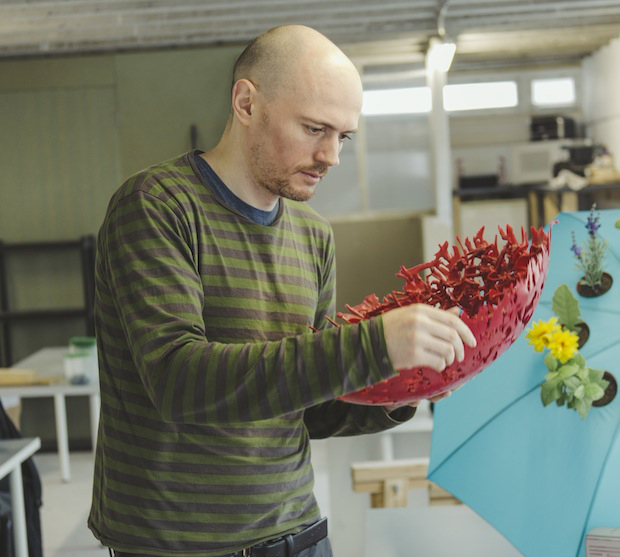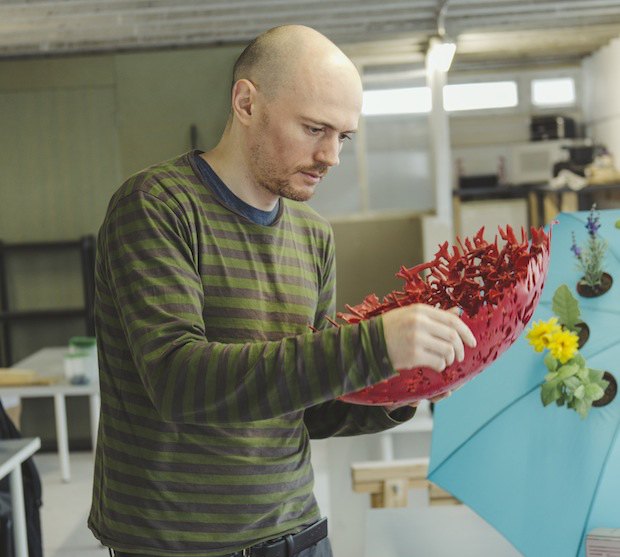Dominic Wilcox
Straight from the pages of the latest Protein Journal comes our interview with the charmingly odd serial inventor


Originally printed in the Protein Journal #12, available here.
It doesn’t take long to realise that Dominic Wilcox is something of a genius. He chuckles boyishly after each question and explains every project he’s worked on with the logic of a scientist. The descriptions of his projects fly by in a blur, his dialogue is erratic – and insightful – as is his creative output. Part thinker, part artist, part designer, Sunderland-born Wilcox turns his penetrating eye to places of human invention to explore questions that have been on his mind for years. “I try to convince myself that within everything there are hundreds of ideas ready to be found,” he explains. “As an artist, I think you need the confidence to know that you can extract interest and intrigue with any item.”
And it’s true; he has experimented with a plethora of objects from football boots to gold-plated skimming stones. He’s even toyed with the idea of genetic modification, though he is keen to make his opinion on the 3D printer clear: “The thing with rapid prototyping is that it’s not really that rapid. That's not to reject the whole thing because obviously they can be very useful for manufacturers and designers. I just don't see them being in every home in the future as some people predict.” Wilcox raced against a 3D printer back in 2012 during Salone del Mobile design week: a man against machine. Wilcox used clay while another team of designers used a 3D printer to create a version of Milan’s cathedral. “It wasn't about the finished objects, it was more a comment on technology and the value of the hand made object. The imperfect, hand made object has a character or personality that computer created things can't match. There's a lot of over the top hype around 3D printers and I can understand why, watching an object being created from nothing is kind of magical. Ultimately though, once the novelty wears off, it's just another tool, you still need a good idea to start with.”
His nomadic approach, and ability to not get tied down to specific styles or materials, is likely informed by his experience as a design student. After gaining a BA at Edinburgh College of Art, he took himself off to Japan, returning to take up a place at the Royal College of Art. “When I first started out, my work was principally idea-based; the notion of starting with an idea and communicating it. Whilst at the RCA, I started experimenting with materials, finding surprises through experimentation; it’s a different approach to just sitting with your sketchbook.” His descriptions of his early work conjure up images of a younger Wilcox, sans safety goggles, recklessly investigating with lighter fluid and blowtorches. “You can find ideas within materials, taking items people haven’t melted or burnt or whatever, and always find surprises.”
Indeed, there is a refreshing thread of humour that shines through his extensive catalogue. This comical aspect is perhaps best explored in his sketchbook Variations on Normal, soon to be published as a book. Still in development, it’s an anthology of his more outlandish ideas: projects not yet realised, logical and illogical inventions and contraptions such as shoes with angled soles to assist in walking uphill, or an all-in-one poncho for a family of five.
As an artist, I think you need the confidence to know that you can extract interest and intrigue with any item “Sometimes I can't imagine what something will be like until I make it, I find that quite exciting. I'll try to visualise things in my head, on paper, or even with 3D software but if I really can't picture it I have to make it.” So does he see objects or people as catalysts for his work? “I think I make work about people through the vehicle of objects. A ruler, for example, represents what we do, more than the object itself. I’m telling stories, or creating a commentary, about human behaviour through objects.” But the nature of these objects is simultaneously familiar and surreal, and they “mostly have one foot in normality and another foot far away from that.”
His designs ask sometimes pertinent, sometimes silly questions about a whole manner of topics. “You just start to have opinions on things and you make observations on the way people behave.” A good example of this, and one that captures the whimsical nature of a lot of his designs, is the Reverse Listening Device, a cartoon-esque headpiece that allows the wearer to swap the direction in which their ears hear. The device was made as part of his window display for Selfridges’ Festival of Imagination, which gave him the chance to bring some of his more unfeasible designs to life. “I was just taking these sketches that I already had but making them real. There’s always this line between what can remain a sketch and what gains added value by being made.”When asked about objects he sees on screens, on television, on computers or via the internet, sources one might assume he’d treat with the same questioning approach as the 3D Printer, he says, “I feel a bit dead inside about screen-based art. I’m staring at a screen all day, whether it’s the phone or my computer, and there’s a barrier between us. What I’m more excited about is wearable technology – that still involves the internet, but it’s about taking the internet out of the screen, using it to using it to enhance our everyday lives.” Taking his designs off the page and making them real is often vital to successfully getting his ideas across. A good example of the importance of physicality is his No Place Like Home project, which saw him create a fully functioning pair of shoes that guide the user via GPS hidden in the heel – the Google Map generation’s version of the slippers that Dorothy would click together to take her back to Kansas.
And when you’re dealing with ideas that exist somewhere between the scribblings of an overactive five-year-old and the drafts folder of a mad scientist, having the chance to turn your ideas into reality is a rare luxury. Which is usually the point at which brands come in. Predictably, the range of brands Wilcox has collaborated with is as diverse as his own work. For Nike, he created Cave, a shoe container consisting of thousands of melted toy footballers, while another commission, for McVite’s, resulted in replications of British landmarks made entirely out of carefully chewed Jaffa Cakes. His brand work carries with it his characteristic oddball approach – an approach he’s unwilling to compromise on. “When I work with big brands I make it clear that their ideas can’t influence mine,” he says. “The brand’s role is simply setting the limitations, setting the brief. Once they’ve done that then it’s over to me to do my thing.”
It’s important, he says, for his work to ask more questions than it answers. “The viewer can finish the journey in whatever way their imagination takes them – that is the essence of my work and how I like to communicate my ideas. It’s more about passing something on to the viewer so they can take it in their own direction.”
Does it ever go wrong? Has the user ever spun off on a tangent, and misinterpreted the ‘brief’ that he’d laid out? “Oh yes, that happens a lot. I did an installation in Milan and invited people to bring in sticks, any type of stick – broomsticks, chopsticks, tennis rackets – I was going to gaffer-tape them to a chair to see what object emerged. On the final day I walked into the room and people had started adding their own things to the structure, a bit like christmas decorations. That's one of the things that makes improvised making so exciting, the surprising twists.” There’s no doubt that when Variations on Normal is released this summer, people will have an even deeper understanding of the genius that is Dominic Wilcox. On the other hand perhaps not; perhaps we’ll never fully understand the ideas or his logic. Perhaps that’s actually the more charming option.
http://dominicwilcox.com/



Discussion